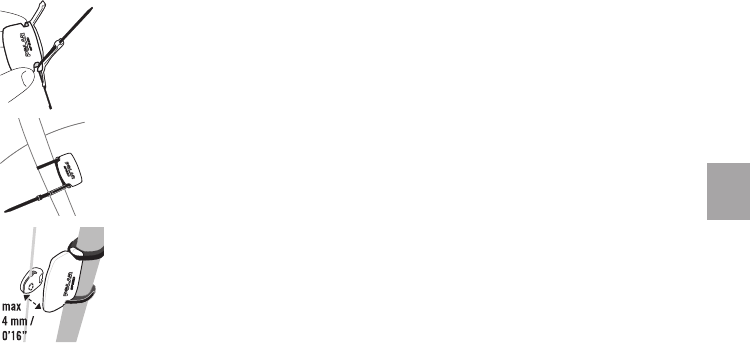
9
ENG
3. Pass cable ties through the sensor and rubber part holes (picture 3). Adjust the sensor to the front fork so that
the POLAR logo faces outward (picture 4). Adjust the ties loosely. Do not tighten them fully yet.
4. Attach the magnet to a spoke at the same level as the sensor (picture 5). The magnet hole must be facing the
speed sensor. Fasten the magnet to the spoke and tighten it loosely with a screwdriver. Do not tighten it fully
yet.
Fine-tune the positioning of both the magnet and the speed sensor so that the magnet passes close to the
sensor but does not touch it. Adjust the sensor towards the wheel/spokes as much as possible. The gap between
the sensor and the magnet should be under 4 mm/0’16’’. The gap is correct when you can fit a cable tie just
about between the magnet and the sensor.
5. Attach the wrist unit to the bike mount and start a CYCLING exercise. (See chapter 3.2 Record Your Exercise.)
Rotate the front tyre so that you can see a speed reading on the display. The reading indicates that the magnet
and the speed sensor are positioned correctly. Tighten the screw on the magnet and the cable ties securely and
cut off any excess cable ends.
BEFORE RIDING YOUR BIKE
• Makesurethatyoucanturnthehandlebarandthepedalsnormally,andthatthecablewiresforbrakesor
gearing do not catch on the bike mount or sensors.
• Enterthewheelsizeofyourbicycleintothecyclingcomputerforaccuratespeedanddistancereadings.
For further information, see chapter 2.3 Bike Settings.
Note:
• Startexercisingslowlyandkeepyoureyesontheroadtopreventanyaccidentsandinjury.
• Avoidhardhitstothespeedsensorasthesemaydamageit.
• Polarspeedsensormaybeusedintherain.
3.
4.
5.


















